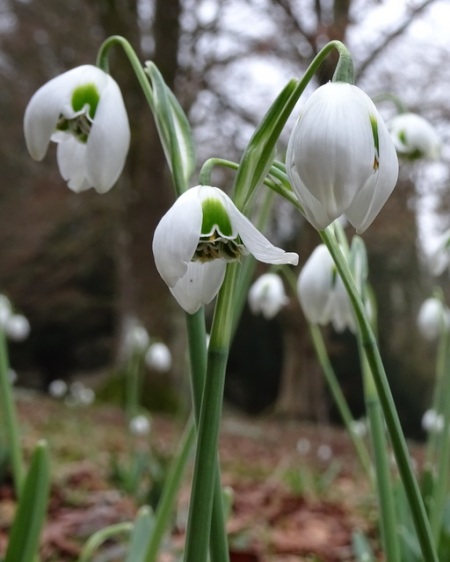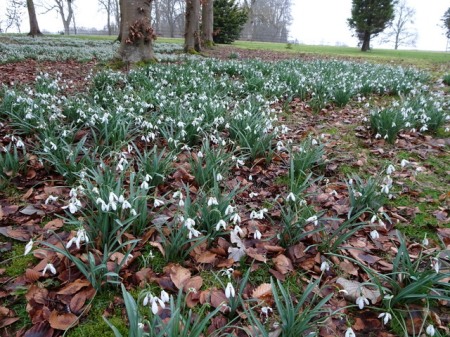Drifts of Snowdrops at Colesbourne Park
 A drift of snowdrops covers the hill above the extraordinarily colored lake at Colesbourne Park. The amazing blue is caused by light reflecting off naturally deposited clay in the water. It is worth visiting just to see it.
A drift of snowdrops covers the hill above the extraordinarily colored lake at Colesbourne Park. The amazing blue is caused by light reflecting off naturally deposited clay in the water. It is worth visiting just to see it.
Our current snowdrop catalogue is on line here.
Michael and I just returned from a two week snowdrop trip to England. For six days we were the guests of Sir Henry and Lady Carolyn Elwes at Colesbourne Park in the Cotswolds. Colesbourne has been called England’s greatest snowdrop garden, and wandering through the grounds for six days I can see why. First, the 2,500 acre setting is absolutely magnificent, including the lake pictured above, a church dating back to 1067, and a charming village with a delightful pub, the Colesbourne Inn, serving delicious food.
Nursery News: Carolyn’s Shade Gardens is a retail nursery located in Bryn Mawr, PA, specializing in showy, colorful, and unusual plants for shade. The only plants that we ship are snowdrops and miniature hostas. For catalogues and announcements of events, please send your full name, location, and cell number (for back up use only) to carolyn@carolynsshadegardens.com. Click here to get to the home page of our website for catalogues and information about our nursery and to subscribe to our blog.
.
 This lovely, very large snowdrop ‘Margaret Owen’ is a fitting tribute to its namesake, a renowned galanthophile.
This lovely, very large snowdrop ‘Margaret Owen’ is a fitting tribute to its namesake, a renowned galanthophile.
.
 The double snowdrop ‘Rodmarton’ originated at the nearby Rodmarton Manor, an arts and crafts house featuring its own wonderful snowdrop collection.
The double snowdrop ‘Rodmarton’ originated at the nearby Rodmarton Manor, an arts and crafts house featuring its own wonderful snowdrop collection.
Second, you can see many rare and unusual snowdrops, like ‘Margaret Owen’ and ‘Rodmarton’ above, in large clumps instead of singly or in small groups. Colesbourne Park has over 250 varieties in its collection, and they work hard to develop each into a large stand.
.
 Sir Henry Elwes stands in a field of ‘S. Arnott’ as he entertains a guided tour with tales of Colesbourne and its snowdrops.
Sir Henry Elwes stands in a field of ‘S. Arnott’ as he entertains a guided tour with tales of Colesbourne and its snowdrops.
Third, if you are lucky enough to go on a tour, you will be taken around by Sir Henry Elwes who grew up at Colesbourne and knows all 2,500 acres intimately. His great-grandfather was Henry John Elwes, the famous Victorian plant explorer who discovered his namesake snowdrop, Galanthus elwesii, in Turkey in 1874. During the tour, Sir Henry will tell you about snowdrops, but he will also regale you with fascinating stories about Colesbourne itself.
.
 A close up of ‘S. Arnott’, called the desert island snowdrop because if galanthophiles could have just one, this would be it!
A close up of ‘S. Arnott’, called the desert island snowdrop because if galanthophiles could have just one, this would be it!
But for me, the most amazing thing about Colesbourne is the huge drifts of some of the more well known cultivars of snowdrops. As I have said before, I am not interested in having a collection of hundreds of little groups of rare snowdrops. I want plants with interesting leaves and habits as well as flowers, that are vigorous and will multiply into large clumps fairly quickly.
.
 ‘Titania’, a Greatorex double snowdrop, which has been intentionally divided and spread out at Colesbourne.
‘Titania’, a Greatorex double snowdrop, which has been intentionally divided and spread out at Colesbourne.
When Sir Henry and Lady Carolyn Elwes took over Colesbourne Park, intervening generations had not tended John Henry Elwes’s collections and many had been sold. However, some snowdrops remained, and Sir Henry and Lady Carolyn developed the current Colesbourne snowdrop display in the last 25 years. Colesbourne showed me what you could do with a snowdrop collection and why snowdrops like ‘S. Arnott’ and the others pictured below are so widely grown. It was a revelation.
.
Here are some more snowdrops that have been systematically divided to form huge stands at Colesbourne:
.
 ‘Galatea’, a large and vigorous single snowdrop, called “one of the foundation stones of many collections” by Matt Bishop’s snowdrop book.
‘Galatea’, a large and vigorous single snowdrop, called “one of the foundation stones of many collections” by Matt Bishop’s snowdrop book.
.
 ‘Galatea’ quickly turns into a good sized patch.
‘Galatea’ quickly turns into a good sized patch.
.
.
 ‘Ophelia’ is my favorite of the many Greatorex doubles and also the most widely grown.
‘Ophelia’ is my favorite of the many Greatorex doubles and also the most widely grown.
.
 ‘Ophelia’ as far as the eye can see.
‘Ophelia’ as far as the eye can see.
.
 Early-blooming ‘Mrs. Macnamara’, another much admired classic called a “plant of great quality” by the Bishop book.
Early-blooming ‘Mrs. Macnamara’, another much admired classic called a “plant of great quality” by the Bishop book.
 ‘Hippolyta’ spread far and wide.
‘Hippolyta’ spread far and wide.
.
 Galanthus plicatus ‘Colossus’, an early vigorous snowdrop with a beautiful habit and elegant leaves.
Galanthus plicatus ‘Colossus’, an early vigorous snowdrop with a beautiful habit and elegant leaves.
.
I visited some other snowdrop venues that had sweeping drifts but none with the variety found at Colesbourne. Painswick Rococo Garden is the place where the famous snowdrop ‘Atkinsii’ was first selected in the 1860s. There are amazing drifts of ‘Atkinsii’, Galanthus nivalis, and ‘Flore Pleno’ there:
.
 The very tall and stately ‘Atkinsii’ in the back with ‘Flore Pleno’ in the front at Painswick.
The very tall and stately ‘Atkinsii’ in the back with ‘Flore Pleno’ in the front at Painswick.
.
Thank you so much to Sir Henry and Lady Carolyn Elwes for opening their world, both snowdrop and otherwise, to two very grateful visitors from across the pond.
Carolyn
.
Note: Every word that appears in orange on my blog is a link that you can click for more information. If you want to return to my blog’s homepage to access the sidebar information (catalogues, previous articles, etc.) or to subscribe to my blog, just click here.









March 3, 2017 at 7:47 am
When is the best time to divide snowdrops ?
Sent from my iPhone
>
March 3, 2017 at 7:55 am
Hedy, In our mid-Atlantic climate with long hot drought-filled summers, I always divide them right now in the spring when we will have a long period of cool weather with rain to get them acclimated. You must be very careful not to damage the roots or leaves when dividing them. Dig up the whole clump and use a watering wand to wash off the soil before gently separating the intertwining roots. Replant at the same depth in organic soil in deciduous shade. Give them some liquid organic fertilizer, I use fish emulsion, and keep them watered until they are re-established. Carolyn
March 3, 2017 at 9:03 am
Hello Carolyn,
A lovely record of your trip, and what a shame neither of us are close enough to revisit Colesbourne once a week thro’ the season, to see how the vistas change, as the flowers mature, ….
best wishes,
Julian
March 3, 2017 at 9:11 am
Julian, I would love to actually go there on a sunny day as snowdrops look great against a blue sky. There was no sun while I was there. Most of my snowdrop photos show flowers dripping with water as it was always raining or snowing. Carolyn
March 3, 2017 at 6:26 pm
wondering if the garden might be open for a visit on friday march 17? Will be at the flower show and visiting a client in Malvern
March 3, 2017 at 8:24 pm
The garden is only open for garden visits during the open house sale dates: https://carolynsshadegardens.com/csg-2017-spring-sale-dates/. Customers can make an appointment anytime if they wish to shop and as part of the appointment they can walk around the garden.
March 5, 2017 at 1:19 pm
I am coming from New Hampshire to the flower show and also interested in getting some helebore if you have any available. I was hoping to combine the activities since it is difficult for me to come to the area otherwise. I also left a phone message should this option not be a public one. Thank you
March 6, 2017 at 11:42 am
I should be able to arrange for you to shop for hellebores around the flower show. Carolyn
March 6, 2017 at 2:53 am
Colesbourne is my favourite snowdrop garden. The day we went to Painswick it was freezing and all the snowdrops were lying down! It sounds as though you had a wonderful trip.
March 6, 2017 at 11:43 am
Pauline, I am sure you have seen many more snowdrop gardens than me given that you are local. I can’t imagine a better one than Colesbourne, and you have confirmed it. Yo do need to go back to Painswick when the snowdrops are standing up though. Pretty amazing sight. Carolyn
March 6, 2017 at 10:19 pm
What a wonderful experience and wonderful for us as well since you so generously posted about it. Makes me want to get out and divide some of my plants!
March 7, 2017 at 8:15 am
Linda, I have been dividing ever since I got home. Carolyn
March 7, 2017 at 2:13 pm
Lovely. Thanks for taking us on this virtual tour.
Could you answer a question for me please? Half of my snowdrops have come out here in MD, but some were buried under fill dirt to correct drainage problems. I don’t see them yet. The amount of dirt added was 8 inches at the deepest point. Should I wait longer? Dig them up? If the leaves come up but there is no flower, could they store energy and change their depth for next year? Thanks!
March 7, 2017 at 2:30 pm
I read about snowdrops “self-adjusting” from a blog by John Grimshaw. I just wonder if digging up my snowdrops would be better than waiting to see if they will do it themselves? 🙂
March 7, 2017 at 3:28 pm
Melissa, Snowdrop bulbs do adjust themselves to the right depth, but I am afraid that 8″ of fill might be too much for them to come up through. You should be seeing leaves and any accompanying flowers by now. I would recommend digging up all the bulbs and replanting a few inches deep if they are Galanthus nivalis, the common snowdrop. If they don’t have leaves though, there will be nothing to replenish the bulbs for next year. Good luck, Carolyn
March 7, 2017 at 6:50 pm
Thanks for your advice! I will be digging tomorrow. If things are grim, I will want to mail order some nivalis. According to the website you still have some?
March 7, 2017 at 7:20 pm
Yes, I do but I hope you don’t need it!
March 12, 2017 at 10:57 pm
Lovely. Thanks for the vicarious visit. No drifts of snowdrops here; just drifts of snow.
March 13, 2017 at 9:10 am
Jean, We are having the same freezing weather that you are in Maine only no snow yet which is terrible for the plants. Many buds killed on important trees and shrubs, so sad. The snow is coming on Tuesday and estimates range between 3 and 12″ with wind gusting to 40 mph. I don’t mind the snow but could definitely skip the wind. Winter isn’t what it used to be. Carolyn